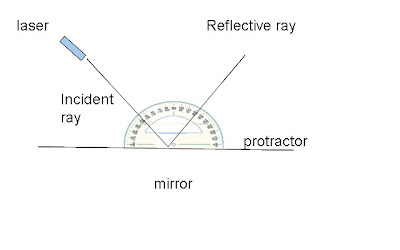Today in Period 2 Science we:
1. Talked about the scattering of light, otherwise known as why we don't see a concentreted reflected ray on some surfaces. The "some surfaces" in class was the wall. The wall was very rough, so we thought that the reason there is no concentrated ray because it was too rough. We also tested this on the mirror and whiteboard, confirming the fact that smooth and polished surfaces reflect a concentrated ray. We also used pond as an example; you can see your reflection in a pond when it is calm, then, when you throw a rock into it (making the surface rough, in a way), you can't see your reflection anymore.
2. However, when you point a laser at a window, which is smooth, it doesn't reflect off. So, we tested different surfaces with the laser to see which different surfaces reflect the laser.
Here's what we tested:
Window: not really, goes through
Wall: doesn't reflect
Glass test tube: not really, kinda goes through it
Plastic test tube: not really, just kinda goes through it
Person's jacket: no
An arm: no
Table: a little bit
Glossy poster: reflects off pretty well
Paper: sort of reflects and scatters at the same time
So, the light and the reflection is affected by the texture of the surface.
It is also affected by the color; for example: the black table, even though it was kinda shiny and flat, only reflected a little bit because the black color is absorbing some of the light.
There is a term for the idea that light can go straight through some surfaces; and that is transparency. This means that light can freely pass through it. An example of this is a glass beaker.
However, there is another term; it is translucent. This means that some light can pass through, but some also light also clearly reflects/absorbs some. An example of this is a window.
Opaque means that the object is solid, such as a shirt or something solid.
MA


 The wave legnths are further apart.
The wave legnths are further apart.  Today in class we went over why when you shine the laser, only certain people at a certain angle can see it.
Today in class we went over why when you shine the laser, only certain people at a certain angle can see it. Why can we see a dot on the mirror?
Why can we see a dot on the mirror?

